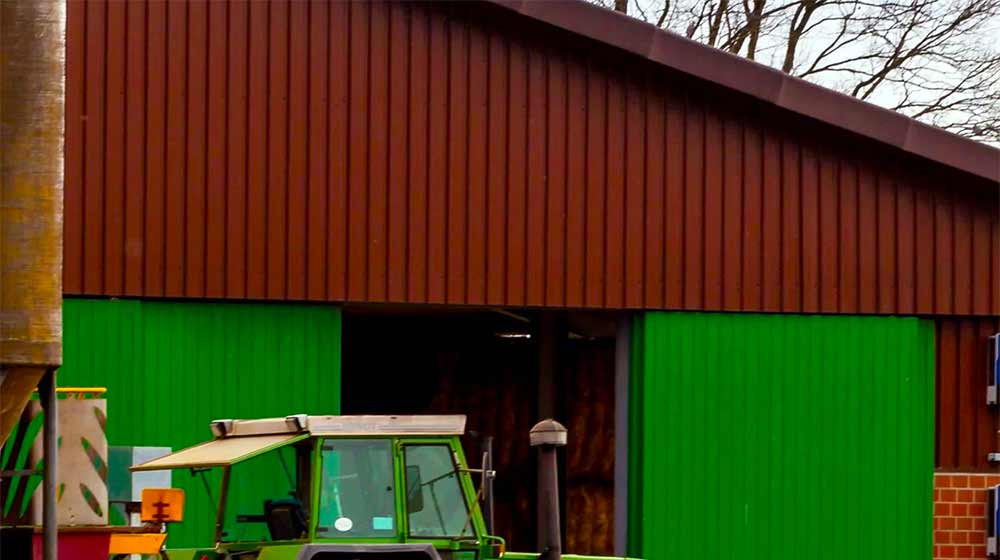All Blogs, Hygiene, Priming and Protecting, Weatherproofing
How to Paint and Protect Barns, Farm Buildings and Log Cabins
Here are our top tips for painting farm buildings, barns, sheds, log cabins, summerhouses and well, pretty much any garden building.
Where individual blogs with comprehensive information about particular surfaces are available, we have linked to these too. We have (unashamedly) referenced some of our own products here because:
- They are relevant
- We know that they will do the job
- As they are made here in Britain, they comply with all the relevant standards you might need to be aware of
Painting Farm Buildings
To optimise their lifespan (and economy), regular inspection and painting of farm buildings is vital. This not only ensures that buildings are protected against corrosion and rotting, but also makes them easier to clean and keeps them looking smart! Here are some of the paints we recommend:
Barn Paint:
A good barn paint will provide protection against the weather and from insect attack etc. Bitumen is a versatile, weatherproofing product and in our Carbolustre barn paint it has been blended with alkyd resins to give both waterproofing and flexibility.
The finish is slightly glossy and because of the bitumen content it is available in colours that are mainly richer or darker. If you are looking for white or pale/pastel shades for your barn then consider one of the other options. In an agricultural setting bituminous barn paint is a good choice not only for barns, but also for structures, doors, gates and stables.
This paint is also perfectly suitable for using on garden sheds and stables and we’ve even had customers using it on pagodas, gazebos and pergolas. Suitable for use on both wood and metal, barn paint is slightly more economical than traditional “farm” oxide gloss.
For protection on old timbers like those in the image above, barn paint is a good option or choose Carboblack bitumen paint which has a higher bitumen content. Further reading: Questions About Bitumen Paints
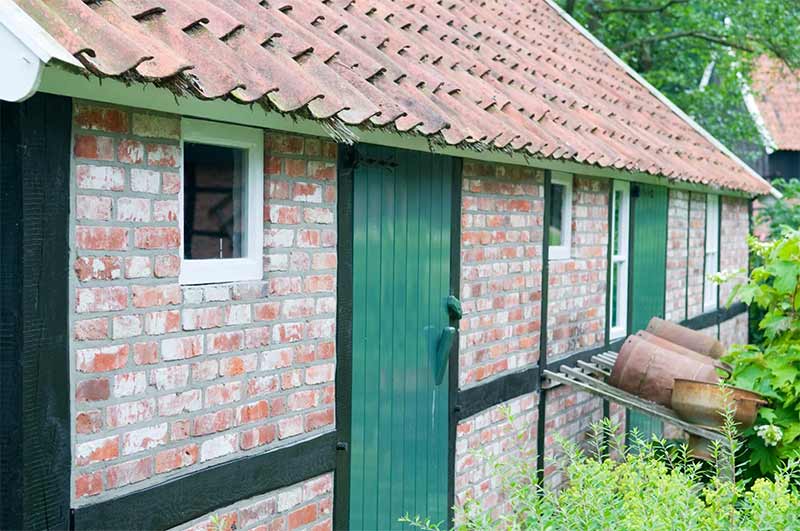
Farm or Agricultural Gloss:
Traditional agricultural oxide gloss or ‘farm gloss’ has been used to protect farm buildings and structures for many years. Our Carboxide Agricultural and Industrial gloss is a great option especially if you are painting metal barns and farm buildings.
It has the advantage that it can be used to paint over previously painted surfaces, is fast drying, easy to apply and usually only requires one coat. For bare surfaces it is usually better if applied over a primer, we generally recommend either red oxide primer (also in grey, white and black) or anti corrosive metal primer from our Carboxide range.
The finish, as the name suggests is ‘gloss’ and there is a wider variety of colours than in the barn paint, including white and paler shades. Because it is suitable for use on a variety of surfaces, our agricultural customers use this protective gloss in large quantities on metal and wooden barns, sheds, cages and other structures. In particular, this also allows for coordination of colour to maintain farm branding etc. Unsure about the metal primer you need?
Further reading: Which Metal Primer to Use and When
Chlorinated Rubber Paint:
Sometimes hygiene and the ability to deep clean frequently is a priority. Chlorinated rubber paint is a solution to this as it’s resistant to many chemicals (including urine) and mould and is easy to hose down frequently. Like the paints above, chlorinated rubber paint will also help protect buildings for longer and is ideal to use on livestock areas, animal feed storage areas, silos, milking parlours, stables and kennels.
It’s fine to use on a concrete floor as well as on the exterior or interior walls (make sure areas is ventilated when applying). The finish has a sheen to it and colour choices are not usually restrictive. Take care when applying this product (Further reading: Chlorinated Rubber Paint and its Uses).
If you are painting animal housing, then really any of the above paints will be suitable, the choice is yours!
Because we mainly supply to businesses and industry we generally recommend solvent borne paints for exterior use because of their proven longevity and protective qualities. If you consider a matt or satin finish might look better on your dog’s kennel or your stable then you could also look at the options for log cabins below.
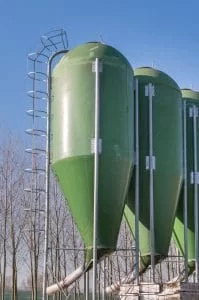
Painting a Timber Lodge, Log Cabin or Wooden Chalet
Looks matter when you’re painting this kind of building. You may want to show the natural grain and colour of the wood, alternatively you may prefer a solid block of colour to blend with the environment. or stand out with a rich, striking vibe.
As well as good looks, paint for a larger building like a log cabin, usually needs to be fairly quick drying, protective and easy to apply. Generally these kinds of buildings are pre-treated in some way and can often be left uncoated for a short while, but for additional protection and appearance, there are various options.
If you are looking at showing of the natural grain of the wood then a clear log cabin treatment is the best to choose. Many of these, like Barrettine’s log cabin treatment are available in different shades that blend with the environment, but which are also translucent enough to show the wood.
Some of our customers also choose to use the Barrettine All in One Decking oil for this type of garden building to coordinate with decking and verandas. If the wood has not been pre-treated then apply a preserver to protect wood from insect attack and rot. Check the label to establish how long you need to allow the preserver to ‘weather’ before overcoating.
Wood on timber lodges and log cabins will eventually start to show signs of wear. If you want to mask this, or if from the start, your preference is for an opaque, solid colour then we recommend our Professional Lodge and Log Cabin paint .
This has a satin (sheen type) finish as in our customer image, which repels dirt while the alkyd resins and oils help to give good protection against the weather. If wood is bare or in poor condition use an oxide primer first (ours are available in grey, white, red or black to coordinate with topcoat colour choice).
Lots of colours can be achieved in this versatile paint, allowing you to blend with nature or stand out from the crowd.
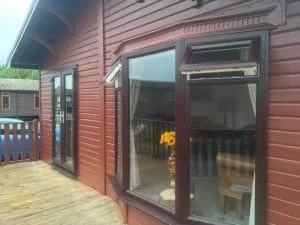
Professional Log Cabin Paint: Chestnut Brown
Summerhouses, sheds, playhouses and garden structures
There are plenty of options available for garden buildings depending on the effect you want to achieve. Like log cabins if the desired finish is for natural wood or stained wood then Barrettine decking oil will give water repellency and help prevent wood splitting.
For a good weather resistant coating on a rough wood shed or log store, consider a creosote substitute, like creocote.
The characteristics of creocote are similar to traditional creosote (water repellences and appearance) it does not however contain the biocide/preserver but the bitumen/wax content still helps repel water. This coating is only suitable for exterior use.
The Palatine Professional log cabin paint is equally suited to summerhouses, with its satin finish and wide choice of colours or for a more contemporary matt finish, oil based, protective coating, and again in many colourways, Professional Shed and Fence paint will work well.
There are other water based coatings on the market but we tend to recommend oil/solvent based paints, like this for lasting exterior protection. There is also nothing to prevent you using barn paint on these types of structure if the finish and colours are to your taste.
For an alternative “stand out from the crowd” beach hut type look, an industrial top coat such as our two hour gloss will do the job superbly. We recommend using our All Purpose Primer for the perfect surface to paint on.
A few tips on roofs and floors in your outbuildings
Most barn floors are concreted (or maybe even cobbled) and floors are generally left bare. If some kind of seal is needed, maybe for dust proofing or ability to keep clean, then a concrete sealer can sometimes help. If hygiene is important chlorinated rubber paint is an ideal option and of course it can be applied on walls too.
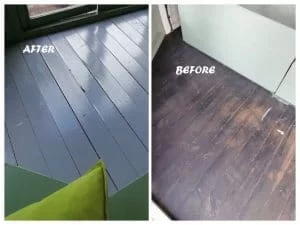
Painted summerhouse floor
For wooden floors in summerhouses and log cabins, you could choose the Barrettine decking oil, or for a hard wearing coloured floor paint Carbotread Anti Slip Polyurethane Floor Paint (pictured below used in a summerhouse) can work well as long it is not exposed to too much humidity.
The majority of outbuilding roofs can be repaired with roofing products including felt adhesive, roofing mastic and roofing compound and coated with Bitumen Paint or Bituminous Barn Paint; more details of these can be in our Bitumens Section.
How to Paint Outbuildings
Here are just a few things to think about when painting outbuildings
- Weather check – it’s unpredictable, but try and make sure there will be a dry spell before painting
- Plants – move any plants away from areas that might come into contact with paint. Until dry, paints of any sort can harm plantlife
- Keep pets away – again until the paint has dried, avoid allowing pets bear where the paint is being applied
- Clean – make sure the area to be painted is grime free and clear of loose debris, lightly sand if needed, to give a smooth surface
- Mask – tape up around windows, doors, knobs and hinges then apply paint around these areas first, by brush
- Apply paint to remaining areas by brush, roller or spray according to manufacturer’s guide
- Unless it’s a one coat application, it’s always best to apply a thin coat first to ensure the surfaces is evenly covered
- Follow the product recommendations in relation to the time period between coats of paint. The first coat may seem dry to the touch, but some of the components may not have had the chance to fully evaporate, this will compromise the drying time of the second coat
We hope this has helped and as always we welcome any comments or photos of your own painted outbuildings.
Contacting us is easy!
Email: [email protected]
Call Us: 01942 884 122
Contact form: https://www.palatinepaints.co.uk/contact-us
As always, we welcome comments below. We also have our online chat manned each weekday during working hours or call/email.

